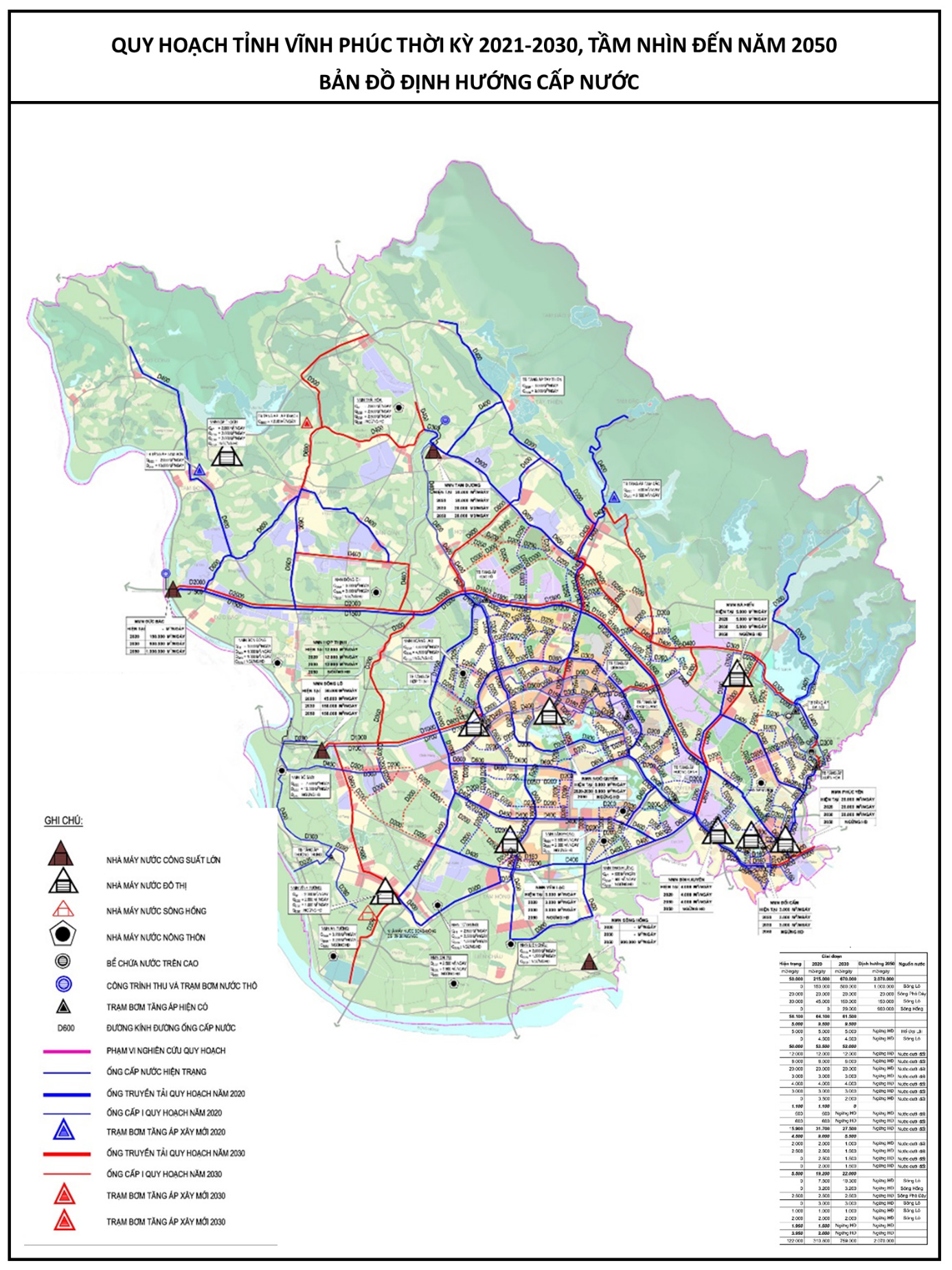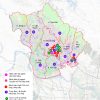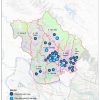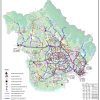
Water supply and drainage infrastructure
1. Water supply infrastructure:
Currently, there are 16 concentrated water supply plants providing water to urban areas, surrounding areas, and industrial parks & clusters in 9 districts and cities located within the province.
The total designed water supply capacity in these areas is 137,000 m3/day and night, with an exploitation capacity of approximately 89,455 m3/day and night, achieving 64.05% of the designed capacity. The percentage of urban residents using clean water is 74.0%, with Vinh Yen city and Phuc Yen city reaching over 93.3%. Considering the coverage rate of the water supply service (areas that have invested in constructing water supply pipelines, ensuring the ability to install water meters and provide water to households upon demand), the coverage rate is over 82% (updated as of July 2022).
There are 10 industrial zones in the province with operating secondary enterprises, totaling 331 production and business enterprises, and all of them have access to water supply at the fence line, achieving a rate of 100%, meeting the demand for production. The total capacity currently in use is around 27,167 m3/day and night (updated as of June 2022). For industrial clusters in the province, the percentage of enterprises using clean water is 24.44% (136/557 facilities).
As of April 2022, the total rural water supply capacity in the province is approximately 27,600 m3/day and night, with an exploitation capacity of approximately 19,000 m3/day and night, achieving 69% of the designed capacity. The average water supply per person per day and night throughout the province is 60 liters, and the water loss rate is 24%. Rural clean water facilities in the province include 44 projects, of which 5 are inter-communal projects and the remaining 39 are at the village and commune level. In terms of management, 10 projects are managed by state-owned enterprises (under the management of the Clean Water and Rural Sanitation Center, belonging to the Department of Agriculture and Rural Development), while the remaining 33 projects are managed by businesses and local authorities. Two projects have not yet been handed over for use.
The projected water demand for the entire Vinh Phuc province by 2030 is 844,895 m3/day and night, As of June 2022, the total designed capacity of water supply plants throughout Vinh Phuc province for urban, surrounding, and industrial areas is 137,000 m3/day and night, and for rural areas, it is 99,120 m3/day and night. Therefore, the projected water demand for the entire province by 2030 is much higher than the current designed capacity of water supply plants. As a result, the province prioritizes expanding and upgrading existing water supply plants, as well as calling for investment in building new water supply plants to meet the demand for water supply for household and production purposes.
2. Drainage infrastructure
Vinh Phuc province has four main river systems for rainwater drainage: the Hong River, Lo River, Pho Day River, and Ca Lo River.
Rainwater drainage area: Vinh Phuc province is divided into three major drainage areas: the Phan River-Ca Lo River drainage area, the Lo River-Pho Day River drainage area, and the Vinh Tuong Bay-Yen Lac drainage area.
Currently, the province has developed a drainage system with nearly 300 km of main drainage canals, including natural drainage systems such as the Phan River and man-made canals such as the Ben Tre Canal and Nam Yen Lac Canal, and nearly 400 km of branch canals. There are 39 large drainage culverts (mostly culverts through embankments) and hundreds of drainage culverts in various areas, as well as numerous local pumping stations to drain the entire land area of the province. However, due to the long-standing construction of these facilities, the design levels are not consistent and cannot ensure effective drainage during heavy rainfall. Furthermore, regular maintenance and upgrading of these facilities are not given sufficient attention, leading to flooding and damage to production.
Most urban areas in the province do not have wastewater treatment plants, and existing residential areas discharge their wastewater into the drainage system for rainwater. Only a few new urban areas have invested in separate systems for rainwater and wastewater.
Vinh Yen city has a centralized wastewater treatment plant with a capacity of 5,000 m3/day and night, located in Quat Luu commune, Binh Xuyen district, along National Highway 2. In addition to the existing wastewater treatment plant, the province is implementing the Vinh Yen Wastewater Treatment Project Phase 2 (under the ODA program) for the development of green urban areas. A new wastewater treatment plant with a capacity of 6,000 m3/day will be constructed in Hoi Hop ward, located in the Western part of Vinh Yen city, to collect and treat wastewater for wards and communes in Vinh Yen city, including Dong Tam ward, Hoi Hop ward, Tich Son ward, and Dinh Trung commune.
Most public hospitals in Vinh Phuc province have wastewater treatment systems, and the quality of treated water meets environmental standards. Industrial parks in the province have also invested in centralized wastewater treatment plants.
The province of Vinh Phuc calls for and mobilizes domestic and international resources for investment in the construction, management, and operation of the drainage system and wastewater treatment plants.




